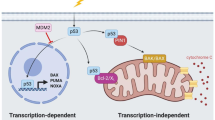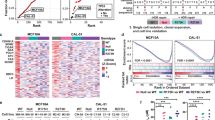Abstract
In vitro studies suggest that effective tumor suppression by p53 requires multiple domains to execute transcription-dependent and transcription-independent functions. We generated a mutant p53 allele in mice, p53W25QL26S (p53QS), containing an inactive transactivation domain to evaluate the importance of transactivation for p53-mediated tumor suppression. Recently, we discovered that the allele also contains a valine substitution for alanine at codon 135, which borders the DNA-binding domain. We found that p53QSval135 bound to chromatin albeit less well than p53QSala135, but both were equally deficient in transcriptional regulation, apoptosis induction in mouse embryo fibroblasts (MEFs), and suppression of tumor formation by E1A, Ha-Ras transformed MEFs. p53QSval135 mice and p53-null mice exhibited identical tumor development kinetics and spectra in spontaneous and oncogene-initiated tumorigenicity assays, when tested in a homo- and heterozygous configuration. The p53QSval135 allele did not have dominant negative functions and behaved as a null allele. Taken together, these data indicate that effective tumor suppression requires the transcriptional regulation function of p53, and they suggest that transactivation independent functions of p53 are unlikely to contribute significantly to tumor suppression in vivo.
This is a preview of subscription content, access via your institution
Access options
Subscribe to this journal
Receive 50 print issues and online access
$259.00 per year
only $5.18 per issue
Buy this article
- Purchase on Springer Link
- Instant access to full article PDF
Prices may be subject to local taxes which are calculated during checkout







Similar content being viewed by others
References
Appella E and Anderson CW . (2001). Eur. J. Biochem., 268, 2764–2772.
Barlev NA, Liu L, Chehab NH, Mansfield K, Harris KG, Halazonetis TD and Berger SL . (2001). Mol. Cell, 8, 1243–1254.
Brooks CL and Gu W . (2003). Curr. Opin. Cell Biol., 15, 164–171.
Caelles C, Helmberg A and Karin M . (1994). Nature, 370, 220–223.
Candau R, Scolnick DM, Darpino P, Ying CY, Halazonetis TD and Berger SL . (1997). Oncogene, 15, 807–816.
Chao C, Saito S, Kang J, Anderson CW, Appella E and Xu Y . (2000). EMBO J., 19, 4967–4975.
Chipuk JE, Kuwana T, Bouchier-Hayes L, Droin NM, Newmeyer DD, Schuler M and Green DR . (2004). Science, 303, 1010–1014.
Donehower LA, Harvey M, Slagle BL, McArthur MJ, Montgomery Jr CA, Butel JS and Bradley A . (1992). Nature, 356, 215–221.
Dumont P, Leu JI, Della Pietra III AC, George DL and Murphy M . (2003). Nat. Genet., 33, 357–365.
Espinosa JM and Emerson BM . (2001). Mol. Cell, 8, 57–69.
Gu W and Roeder RG . (1997). Cell, 90, 595–606.
Harvey M, Vogel H, Morris D, Bradley A, Bernstein A and Donehower LA . (1995). Nat. Genet., 9, 305–311.
Haupt Y, Rowan S, Shaulian E, Kazaz A, Vousden K and Oren M . (1997). Leukemia, 11 (Suppl. 3), 337–339.
Haupt Y, Rowan S, Shaulian E, Vousden KH and Oren M . (1995). Genes Dev., 9, 2170–2183.
Hollstein M, Sidransky D, Vogelstein B and Harris CC . (1991). Science, 253, 49–53.
Jacks T, Remington L, Williams BO, Schmitt EM, Halachmi S, Bronson RT and Weinberg RA . (1994). Curr. Biol., 4, 1–7.
Jimenez GS, Nister M, Stommel JM, Beeche M, Barcarse EA, Zhang XQ, O'Gorman S and Wahl GM . (2000). Nat. Genet., 26, 37–43.
Kaeser MD and Iggo RD . (2002). Proc. Natl. Acad. Sci. USA, 99, 95–100.
Lavigueur A, Maltby V, Mock D, Rossant J, Pawson T and Bernstein A . (1989). Mol. Cell. Biol., 9, 3982–3991.
Leu JI, Dumont P, Hafey M, Murphy ME and George DL . (2004). Nat. Cell Biol., 6, 443–450.
Levine AJ, Momand J and Finlay CA . (1991). Nature, 351, 453–456.
Lin J, Chen J, Elenbaas B and Levine AJ . (1994). Genes Dev., 8, 1235–1246.
Liu G, Parant JM, Lang G, Chau P, Chavez-Reyes A, El-Naggar AK, Multani A, Chang S and Lozano G . (2004). Nat. Genet., 36, 63–68.
Lozano G and Levine AJ . (1991). Mol. Carcinog., 4, 3–9.
Lu X, Magrane G, Yin C, Louis DN, Gray J and Van Dyke T . (2001). Mol. Cell. Biol., 21, 6017–6030.
Marchenko ND, Zaika A and Moll UM . (2000). J. Biol. Chem., 275, 16202–16212.
Martinez J, Georgoff I and Levine AJ . (1991). Genes Dev., 5, 151–159.
Michael D and Oren M . (2003). Semin Cancer Biol., 13, 49–58.
Michalovitz D, Halevy O and Oren M . (1990). Cell, 62, 671–680.
Mihara M, Erster S, Zaika A, Petrenko O, Chittenden T, Pancoska P and Moll UM . (2003). Mol. Cell, 11, 577–590.
Milner J and Medcalf EA . (1990). J. Mol. Biol., 216, 481–484.
Mummenbrauer T, Janus F, Muller B, Wiesmuller L, Deppert W and Grosse F . (1996). Cell, 85, 1089–1099.
Nigro JM, Baker SJ, Preisinger AC, Jessup JM, Hostetter R, Cleary K, Bigner SH, Davidson N, Baylin S, Devilee P, Glover T, Collins FS, Weslon A, Modali R, Harris C C and Vogelstein B . (1989). Nature, 342, 705–708.
Offer H, Milyavsky M, Erez N, Matas D, Zurer I, Harris CC and Rotter V . (2001). Oncogene, 20, 581–589.
Pan H, Yin C, Dyson NJ, Harlow E, Yamasaki L and Van Dyke T . (1998). Mol. Cell, 2, 283–292.
Prives C . (1994). Cell, 78, 543–546.
Rubbi C and Milner J . (2003). EMBO J., 22, 975–986.
Sabbatini P, Lin J, Levine AJ and White E . (1995). Genes Dev., 9, 2184–2192.
Schmitt CA, Fridman JS, Yang M, Baranov E, Hoffman RM and Lowe SW . (2002). Cancer Cell, 1, 289–298.
Stommel JM and Wahl GM . (2004). EMBO J., 23, 1547–1556.
Sturzbecher HW, Donzelmann B, Henning W, Knippschild U and Buchhop S . (1996). EMBO J., 15, 1992–2002.
Symonds H, Krall L, Remington L, Saenz-Robles M, Lowe S, Jacks T and Van Dyke T . (1994). Cell, 78, 703–711.
Tyner SD, Venkatachalam S, Choi J, Jones S, Ghebranious N, Igelmann H, Lu X, Soron G, Cooper B, Brayton C, Hee Park S, Thompson T, Karsenty G, Bradley A and Donehower LA . (2002). Nature, 415, 45–53.
Venkatachalam S, Shi YP, Jones SN, Vogel H, Bradley A, Pinkel D and Donehower LA . (1998). EMBO J., 17, 4657–4667.
Venkatachalam S, Tyner SD, Pickering CR, Boley S, Recio L, French JE and Donehower LA . (2001). Toxicol. Pathol., 29, 147–154.
Venot C, Maratrat M, Sierra V, Conseiller E and Debussche L . (1999). Oncogene, 18, 2405–2410.
Vogelstein B and Kinzler KW . (1992). Cell, 70, 523–526.
Vousden KH . (2000). Cell, 103, 691–694.
Vousden KH and Lu X . (2002). Nat. Rev. Cancer, 2, 594–604.
Wahl GM and Carr AM . (2001). Nat. Cell Biol., 3, E277–E286.
Yin C, Knudson CM, Korsmeyer SJ and Van Dyke T . (1997). Nature, 385, 637–640.
Zhou J, Ahn J, Wilson SH and Prives C . (2001). EMBO J., 20, 914–923.
Zhu J, Jiang J, Zhou W, Zhu K and Chen X . (1999). Oncogene, 18, 2149–2155.
Acknowledgements
We thank Dr Franck Toledo for identifying the third mutation, val135, in the p53QS-targeting construct, Mrs Marianne Kastemar for technical assistance, and Drs Franck Toledo, Jayne Stommel, and Kurt Kummel for critical comments on the manuscript. This work was supported by the Swedish Cancer Society (MN), the Swedish Childhood Cancer Fund (MN) and Erik, Karin och Gösta Selanders Stiftelse (MN), and the NIH (CA61449, GW and CA046283, TVD).
Author information
Authors and Affiliations
Corresponding author
Additional information
Supplementary Information accompanies the paper on Oncogene website (http://www.nature.com/onc)
Rights and permissions
About this article
Cite this article
Nistér, M., Tang, M., Zhang, XQ. et al. p53 must be competent for transcriptional regulation to suppress tumor formation. Oncogene 24, 3563–3573 (2005). https://doi.org/10.1038/sj.onc.1208354
Received:
Revised:
Accepted:
Published:
Issue Date:
DOI: https://doi.org/10.1038/sj.onc.1208354
Keywords
This article is cited by
-
Low expression levels of ATM may substitute for CHEK2 /TP53 mutations predicting resistance towards anthracycline and mitomycin chemotherapy in breast cancer
Breast Cancer Research (2012)
-
Consequences of DJ-1 upregulation following p53 loss and cell transformation
Oncogene (2012)
-
p53 activates transcription by directing structural shifts in Mediator
Nature Structural & Molecular Biology (2010)
-
20 years studying p53 functions in genetically engineered mice
Nature Reviews Cancer (2009)
-
Contribution of p53-mediated Bax transactivation in theaflavin-induced mammary epithelial carcinoma cell apoptosis
Apoptosis (2008)



